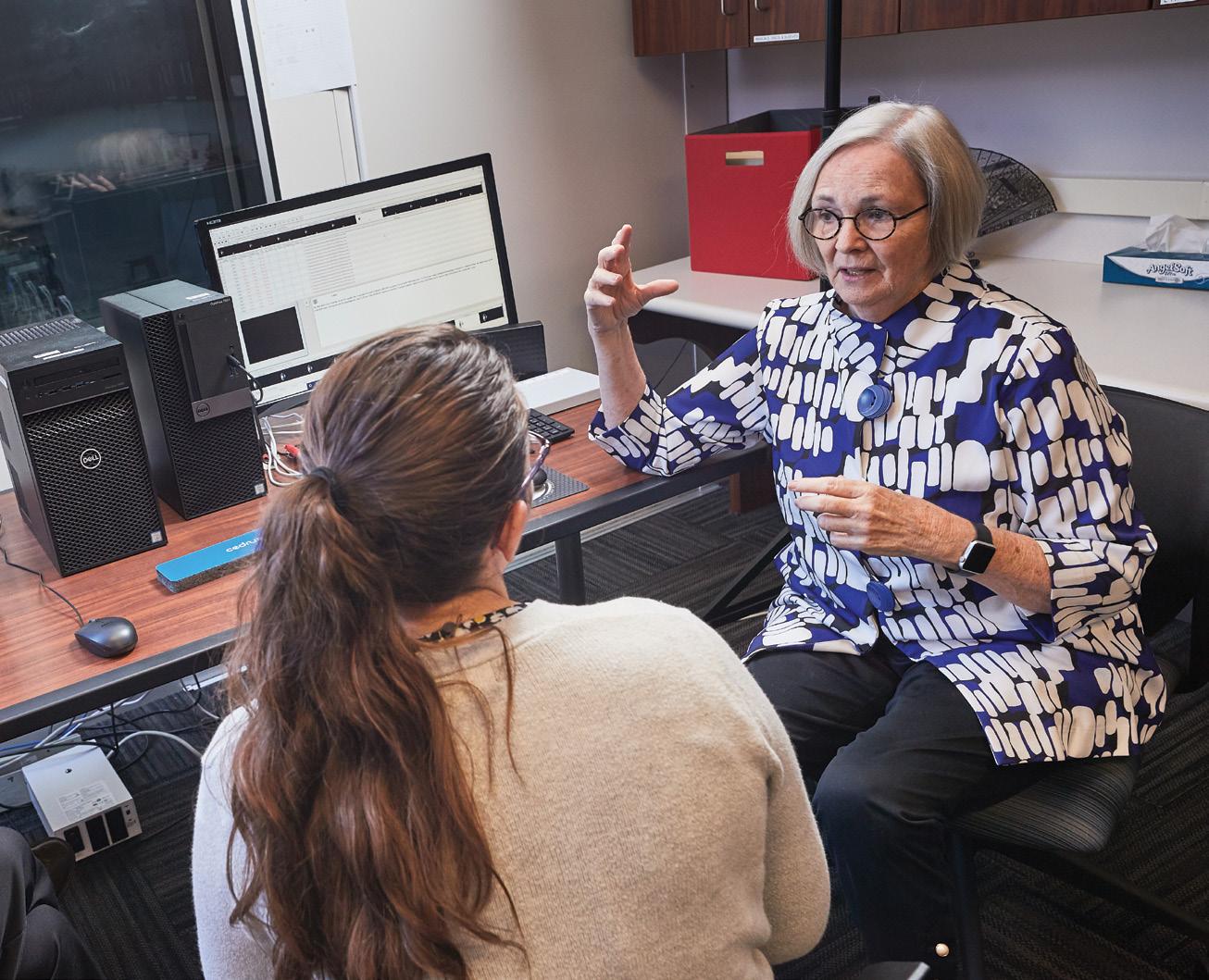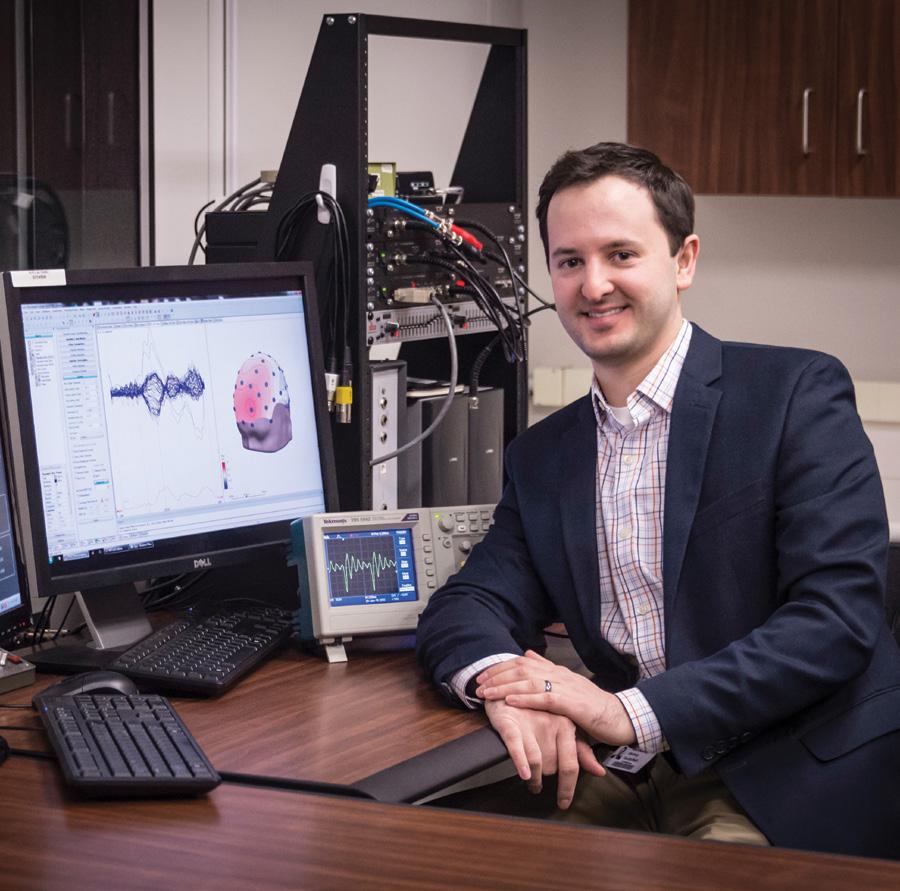
5 minute read
Auditory Processing Laboratory
Deborah Moncrieff, PhD joined the faculty as assistant professor in the School of Communication Sciences and Disorders in 2018. Dr. Moncrieff received her BA in English Literature from the University of Rochester, and after raising three children returned to graduate school and received her MS in Audiology and PhD in Cognition and Neuroscience from the University of Texas at Dallas. She has served in tenure-track and clinical faculty positions at the Universities of Florida, Connecticut and Pittsburgh, changing locations to expand her understanding of auditory processing disorders in children across diverse populations. In addition to behavioral techniques, she has utilized multi-channel electrophysiologic techniques and functional brain imaging to explore the neurophysiologic underpinnings of auditory processing disorders. Her research has been funded by the Department of Veterans Affairs, the Lions Hearing Research Foundation and the U.S. Department of Education.
Research Interests Dr. Moncrieff strives to have an impact on public policies to mandate universal screening, assessment and treatment for specific deficits of auditory processing that negatively impact educational outcomes in children. She has created new tests for clinical assessment of auditory processing disorders (APD) and has called for an alternative approach in diagnosis to differentiate clinical entities that respond to remediation. Toward that end, she coined the term “amblyaudia” to characterize a common binaural integration type of APD that is diagnosed with results from dichotic listening tests and developed Auditory Rehabilitation for Interaural Asymmetry (ARIA), a therapeutic approach for treating amblyaudia. She aims to increase understanding of the critical role played by bottom-up sensory processing in the brainstem on the development of language, learning and reading skills so that children at risk can be identified by the start of elementary school. She uses perceptual learning principles to facilitate neuroplasticity in binaural integration skills that are vital to localization and listening in both quiet and noisy circumstances.
Current Research and Applications Amblyaudia is prevalent in 15-20% of school-age children with variable effects that depend upon its severity. Her focus is to better understand the underlying neurophysiology from the brainstem to the cortex in children with amblyaudia through behavioral and electrophysiologic techniques that explore dynamic operations when the two ears are stimulated together or in competition. She seeks to identify biomarkers of amblyaudia in auditory-evoked responses from the cochlea, to brainstem, to cortex (OAE, ABR, MLR, FFR, ERP) and examine changes following successful treatment with ARIA in those responses and in functional neuroimaging activity. She is developing psychoacoustic methods related to binaural and dichotic processing to delineate primary non-linguistic deficits in children whose struggles are often attributed to deficits in working memory, attention and cognition. Together with University, clinical and community colleagues, Dr. Moncrieff is examining the benefits of diagnosis and treatment of amblyaudia on educational outcomes in a Memphis charter school and among children with significant hearing loss who utilize hearing aids and/or cochlear implants. She hopes that her recent publications on the prevalence of amblyaudia among adjudicated adolescents will bring attention to the potentially significant consequences of leaving this processing deficit untreated as children continue to underperform in school.
Future Endeavors Despite the federal mandate under IDEA, schools in low-income areas lack resources to provide special education services, and disparities in health care limit a family’s access to the benefits available to children of greater means. Widely underserved phonological weaknesses that are known to stem from bottom-up deficits in auditory processing are contributing to the U.S. crisis in literacy, especially in urban schools in poor neighborhoods. Dr. Moncrieff plans to develop a low-cost, accessible web-based technology for assessment and treatment of amblyaudia that can be readily utilized at any school whenever a parent or teacher suspects that a child is at risk of an auditory

processing deficit. To better understand the underlying physiology of amblyaudia, her future research will focus on children with neurologic deficits affecting the corpus callosum and genetic links to the presence of severe amblyaudia. She also plans to evaluate localization capacity in children and adults with amblyaudia in the anechoic chamber before and after ARIA treatment and to use psychoacoustic methods to measure monaural and binaural loudness tolerance in children diagnosed with autism.
Student Involvement Dr. Moncrieff has mentored more than 50 AuD research projects and served in a variety of capacities on the committees of over 10 PhD students. Her lab is open for any student with strong intellectual curiosity who is interested in exploring the complex brain-based interactions involved in human auditory behavior. Students who are highly motivated to investigate how deficits in central auditory processes across the lifespan contribute to reduced benefits from amplification, communication dilemmas in daily environments and failures to develop normal skills in language and reading are encouraged to visit the APL. Researchers in the APL will be trained on techniques involved in developing behavioral and electrophysiologic assessments, recording neural activity in response to auditory stimuli, analyzing and interpreting experimental research data and writing reports of research results for presentation at conferences or in publications. Students in the APL, together with colleagues in Memphis and around the country, are vital players on a team that will advance understanding of human hearing beyond the audiogram and improve outcomes for people of all ages with auditory processing deficits.
Publication Spotlight 1. Moncrieff, D., Miller, E., Hill, E. (2018). Screening tests reveal high risk among adjudicated adolescents of auditory processing and language disorders. J Sp Lang Hear Res, 61:924-935. 2. Moncrieff, D., Keith, W., Abramson, M., Swann,
A. (2017). Evidence of Binaural Integration Benefits Following ARIA Training in Children and Adolescents Diagnosed with Amblyaudia. Int J Audiol, 56(8):580-588. 3. Moncrieff, D., Keith, W., Abramson, M., Swann,
A. (2016). Clinical Evidence on the Diagnosis of Amblyaudia, a Binaural Integration Type of Auditory Processing Disorder. Int J Audiol, 55(6), 333-345. 4. Moncrieff, D. (2011). Dichotic listening in children: age-related changes in direction and magnitude of ear advantage. Brain Cogn, 76(2), 316-322. 5. Moncrieff D, Jerger J Wambacq I, Greenwald R,
Black J. (2004). ERP evidence of a dichotic leftear deficit in some dyslexic children. J Am Acad Audiol, 15(7), 518-34.










